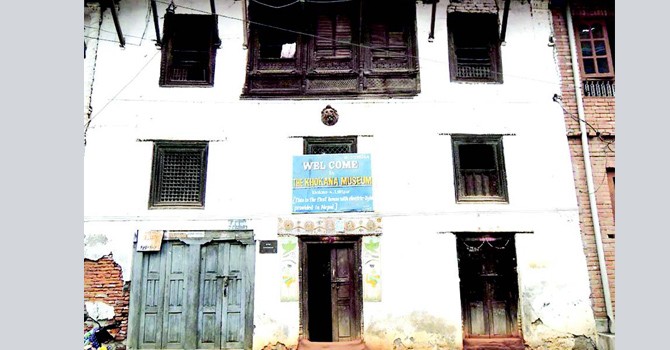Khokana boasts of first house lit up with electricity

By Binu Shrestha
Kathmandu, Nov. 25: Khokana, the medieval settlement in the Kathmandu Valley, is well-known for the production of mustard oil since ancient time.
However, people hardly know that it is the first town in Nepal where the first light bulb had been lit up more than a century ago.
During the reign of Rana Prime Minister Chandra Shumsher Rana, the electricity bulb had been lit up here for the first time in country soon after the completion of Chandrajyoti Hydro-Electric Power Station in 1911.
Before supplying electricity to the then prime minister’s resident, the authority had tested it first at the houses of local residents. During the testing period, they chose four houses of Khokana locals.
Showing the old-fashioned artistic houses, Hari Ram Dangol, of Thalachi of Khokana-4, said, “Out of four houses where the first bulbs were lit, the two belong to my great grandfather.”
These houses are still standing in a line in front of three-storied Rudrayani Temple. Other houses were built in an array position at both sides and there is a lane between them.
All the houses where electricity light was lit first are still highly rich in medieval art. Of them, only one house is now recognised as the Nepal’s first light bulb house. The house was maintained as a museum which has remained closed after the earthquake of 2015.
During the survey of UNESCO, the museum-based house received award and was listed as the
first house that was lit up with electricity power in Nepal, Dangol said.
The museum was set up here in 2015 through the efforts of Madan Krishna Maharjan, Krishna Bhakta Maharjan, Hari Ram Dangol and others.
Dangol said that the electric light was provided to the houses of Bir Bahadur Dangol and Lal Maharjan during that time. Each of them had two houses.
That means the electric light bulbs were lit up at the four houses of the locals before such light was lit at the property of the then highest authority.
The well-known first house with electric light now belongs to Krishna Maharjan, great grandson of Lal Maharjan.
Hari Ram Dangol is great grandson of Bir Bahadur.
Recalling his grandmother’s conservation efforts, Dangol said the day was the most joyful and happiest days of their life when electric light bulb lit up at their houses.
Around one and half months, the electricity was supplied to these houses and to the oil mills of the ancient town of Khokana, he said.
The old-fashioned electric meters set up during that time were square-shaped boxes and seven clocks inside the boxes.
Sharing the experience of old fashioned meter boxes, Dangol said ‘‘I have seen those meter boxes which were later replaced by Nepal Electric Authority saying they created difficulty in reading. They started replacing process in 1998 and it continued to till 2008.’’
Earlier, late kings had used Khokana based route to reach Dakshinkali Temple, which made it easier to them share their problems, he said.
Chandra Shumsher had built Chandrajyoti Hydro-Electric Power Station in 1911 after he visited London in 1908. After getting inspired by the living style and effects of electric light in London, he thought about building an electricity power station in Nepal.
After returning from London, he directed Colonel Kishor Narsingh Rana, executive engineer, for carrying out a survey to produce electricity.
Kishor Narsingh Rana had submitted the detailed report of survey to Chandra Shumsher. But he did not completely rely on his survey report and he invited an engineer from London. He had approved the survey of Colonel Rana.
The construction works of hydro power station got underway under the leadership of Colonel Rana.
Nowadays, the same power station has been turned into a mere source of drinking water. Water from here is supplied to Lalitpur district even though the machines of the oldest power station are still in working condition.
Due to growing shortage of drinking water the Kathmandu Valley Drinking Water Limited had set up a pumping station near the power house in 1981 to meet the demand of drinking water in the valley.
Rajesh Kumar Shrestha, technician of the power station, said that before setting up the water pump, the power station was working in its full capacity. The capacity of the station was 500 kwh. There were two units having a capacity of 250 kwh each.
The full production capacity of the power station declined after the Kathmandu Valley Drinking Water Limited directly connected the pipeline in its reservoir to supply drinking water to Patan, he said.
Recent News

Do not make expressions casting dout on election: EC
14 Apr, 2022
CM Bhatta says may New Year 2079 BS inspire positive thinking
14 Apr, 2022
Three new cases, 44 recoveries in 24 hours
14 Apr, 2022
689 climbers of 84 teams so far acquire permits for climbing various peaks this spring season
14 Apr, 2022
How the rising cost of living crisis is impacting Nepal
14 Apr, 2022
US military confirms an interstellar meteor collided with Earth
14 Apr, 2022
Valneva Covid vaccine approved for use in UK
14 Apr, 2022
Chair Prachanda highlights need of unity among Maoist, Communist forces
14 Apr, 2022
Ranbir Kapoor and Alia Bhatt: Bollywood toasts star couple on wedding
14 Apr, 2022
President Bhandari confers decorations (Photo Feature)
14 Apr, 2022











